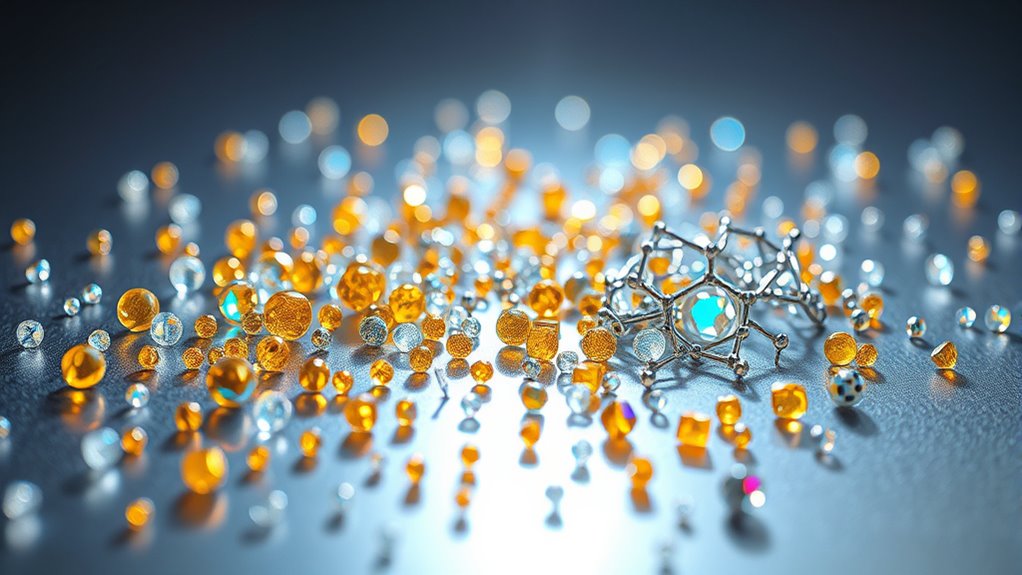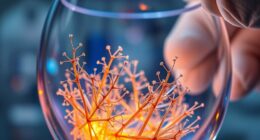Nanocrystals and nanoparticles have unique optical and electrical properties that depend on their size and shape. You can control these features through various synthesis methods like top-down approaches, which shape bulk materials, or bottom-up techniques, building structures atom by atom. Techniques such as chemical vapor deposition, physical methods, or green synthesis using biological agents help create different nanomaterials. Exploring these processes further reveals how surface chemistry and characterization impact their diverse applications across fields.
Key Takeaways
- Nanocrystals and nanoparticles exhibit size- and shape-dependent optical, electrical, and magnetic properties due to quantum confinement effects.
- Surface modifications, including ligand exchange and polymer coatings, enhance stability, biocompatibility, and functionalization capabilities.
- Synthesis methods include top-down approaches like sputtering and bottom-up techniques such as chemical vapor deposition for precise control.
- Characterization tools like TEM, SEM, XRD, and UV-Vis spectroscopy assess size, shape, crystalline structure, and optical properties.
- Green synthesis using biological agents offers eco-friendly, biocompatible options for scalable nanomaterial production.
Unique Optical and Electrical Properties of Nanocrystals and Nanoparticles

Nanocrystals and nanoparticles exhibit remarkable optical and electrical properties that differ markedly from their bulk counterparts. When you work with these tiny structures, you’ll notice they can absorb, emit, and scatter light in ways larger materials can’t. For example, they often display vibrant colors due to quantum confinement effects, which allow their energy levels to be tuned by changing size and shape. Electrically, these particles can exhibit enhanced conductivity or unique charge transfer capabilities, making them valuable in electronics and sensor applications. You might also find that their surface states significantly influence their optical and electrical behavior, enabling precise control over their properties. These characteristics open doors to innovative uses in displays, solar cells, and bioimaging, showcasing how size reduction can lead to entirely new functionalities. Additionally, the prevalence of specific nanocrystal names often guides researchers in selecting suitable materials for targeted applications.
Size and Shape Effects on Nanoparticle Behavior

The size and shape of nanoparticles play a crucial role in determining their behavior and properties. Smaller particles have a higher surface area-to-volume ratio, which enhances reactivity and catalytic activity. Shape influences how particles interact with their environment, affecting properties like optical absorption and magnetic response. For example, spherical particles tend to be more stable, while rods or plates can exhibit unique directional properties. The shape also impacts how particles assemble and how they respond under external stimuli. Understanding surface energy is essential, as it directly relates to reactivity and stability in different particle sizes and shapes.
Surface Chemistry and Functionalization Techniques

Surface chemistry and functionalization techniques allow you to tailor nanoparticles’ interactions with their environment, enhancing their stability, biocompatibility, and application-specific performance. By attaching specific molecules, you can control how nanoparticles bind to surfaces or biological systems. For example, coating particles with polymers or ligands prevents aggregation and improves dispersibility. Functionalization also enables targeted delivery in medical applications, where attaching antibodies or peptides directs nanoparticles to specific cells. You can modify surface charge and hydrophobicity to influence interactions with solvents or biological media. Techniques like silanization, ligand exchange, or polymer grafting are common methods. These modifications are vital for optimizing nanoparticles for sensors, drug delivery, catalysis, or imaging, ensuring they perform effectively within their designated environment.
Top-Down and Bottom-Up Synthesis Approaches
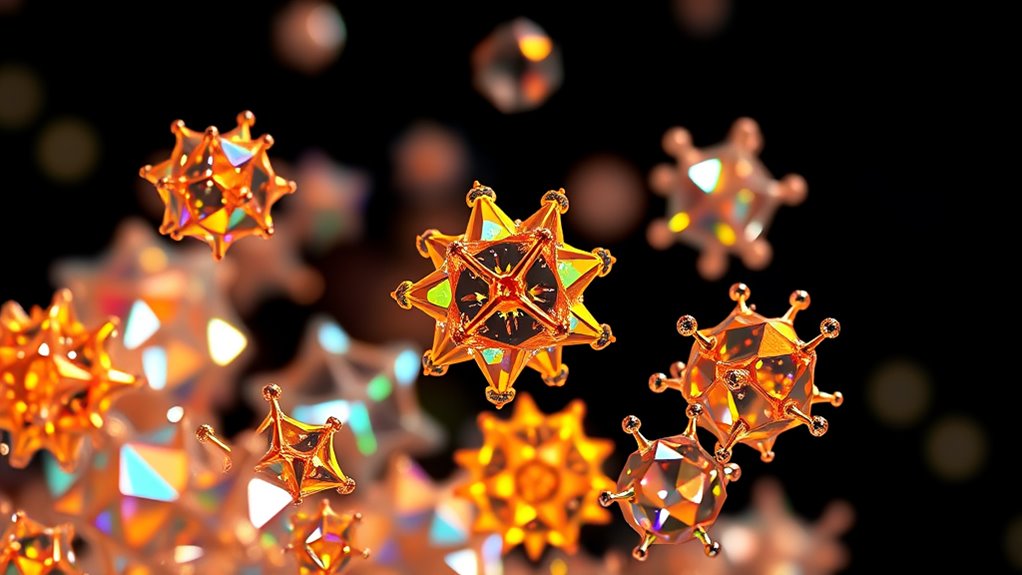
You can create nanomaterials using two primary approaches: top-down and bottom-up synthesis. Top-down involves breaking down bulk materials into nanoscale particles through techniques like milling or etching. This method often results in irregular shapes and size distribution but is suitable for large-scale production. Bottom-up synthesis builds nanomaterials atom by atom or molecule by molecule, typically through chemical reactions, self-assembly, or vapor deposition. This approach offers precise control over size and shape, making it ideal for tailored nanostructures. To visualize these methods:
Top-down and bottom-up approaches enable tailored nanomaterial fabrication with distinct advantages and challenges.
- Top-down resembles sculpting a large block into a tiny sculpture.
- Bottom-up is like assembling a mosaic from individual tiles.
- Both approaches can be combined for complex nanostructures, depending on the application.
- Emerging trends in nanomaterials highlight innovative synthesis techniques and applications.
Choosing the right method depends on your desired properties, scale, and material type.
Chemical Vapor Deposition and Physical Methods

Building on the methods used to create nanomaterials, chemical vapor deposition (CVD) and physical techniques offer precise control over nanocrystal and nanoparticle formation. In CVD, you introduce gaseous precursors into a chamber where they decompose or react on a heated substrate, forming thin films or nanostructures with controlled composition and size. This method allows you to tailor properties by adjusting temperature, pressure, and gas flow. Physical methods, such as sputtering or evaporation, involve transferring material from a source to a substrate through physical means. These techniques enable you to produce uniform nanoparticles with specific shapes and sizes. Both approaches are scalable and versatile, making them ideal for applications requiring high purity and precision in nanomaterial synthesis.
Biological and Green Synthesis Strategies
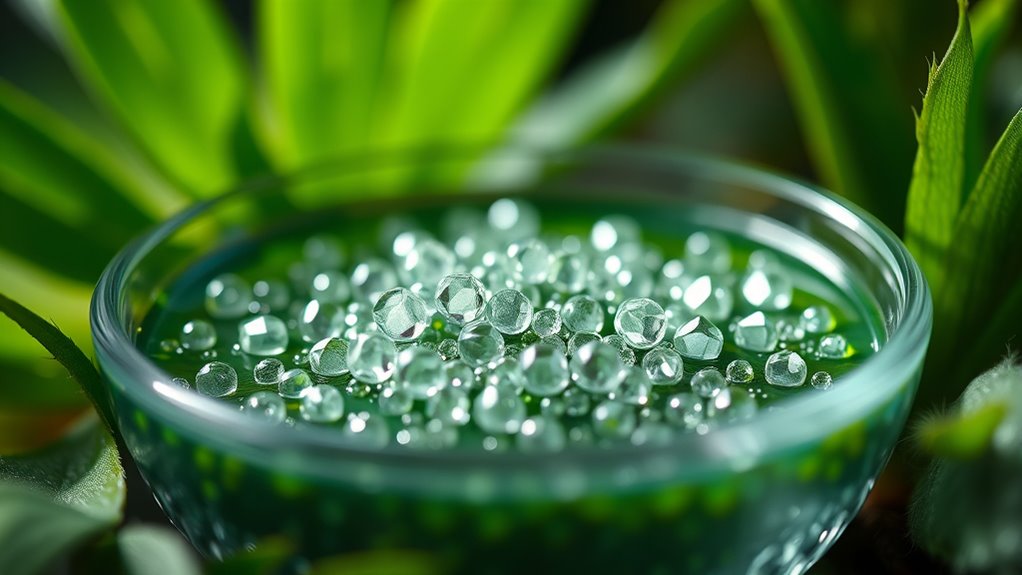
Biological and green synthesis strategies harness natural processes and environmentally friendly materials to produce nanocrystals and nanoparticles. These methods use biological entities or plant extracts to reduce metal ions, avoiding toxic chemicals. You might observe the use of bacteria, fungi, or plant-based materials that act as natural reducing and capping agents. This approach offers eco-friendly advantages, such as lower energy consumption and reduced waste. Imagine green tea extract facilitating gold nanoparticle formation or bacteria synthesizing silver particles. These processes are often straightforward and scalable, making them appealing for sustainable nanomaterial production. By leveraging biological pathways, you can create nanoparticles with biocompatible surfaces, suitable for medical or environmental applications. Additionally, understanding the cultural significance of natural materials can help optimize green synthesis methods. Overall, green synthesis aligns with eco-conscious goals while providing effective, safe nanoparticle production options.
Characterization Techniques for Nanoscale Materials

Characterization techniques are vital for understanding the properties and behaviors of nanocrystals and nanoparticles. You use methods like Transmission Electron Microscopy (TEM) and Scanning Electron Microscopy (SEM) to visualize size, shape, and surface features at the nanoscale. Dynamic Light Scattering (DLS) helps determine particle size distribution in suspension, giving insight into stability and dispersion. X-ray Diffraction (XRD) reveals crystalline structure and phase information, while UV-Vis spectroscopy assesses optical properties related to size and composition. Additionally, techniques like Fourier Transform Infrared (FTIR) spectroscopy identify surface functional groups, and Zeta potential measurements evaluate surface charge, indicating colloidal stability. Combining these methods allows you to thoroughly analyze nanomaterials, ensuring you understand their structure, composition, and surface chemistry essential for their application. Recognizing the importance of Honda Tuning modifications can also inspire innovative approaches to nanomaterial design and optimization.
Applications in Medicine, Electronics, and Energy Storage
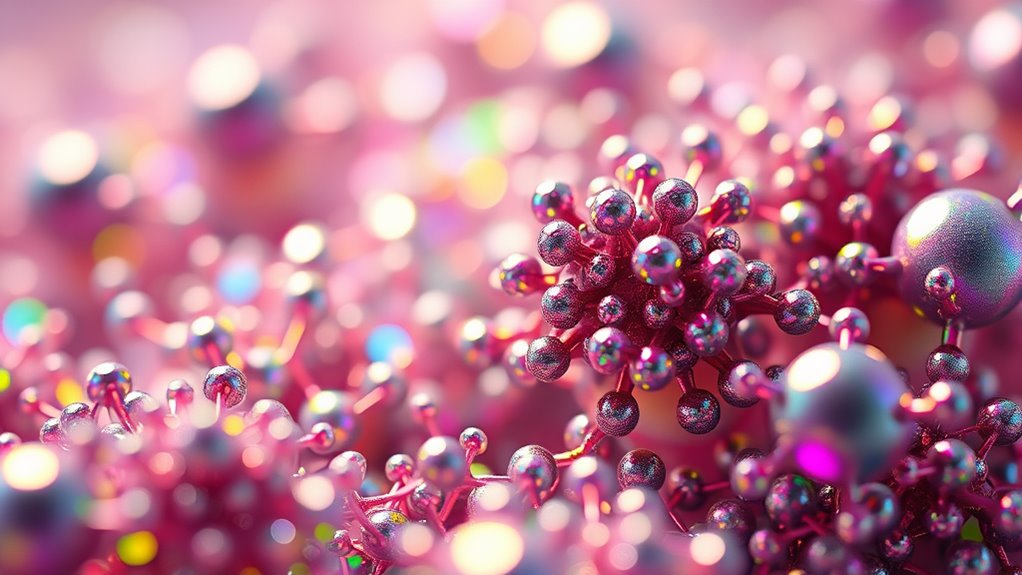
Nanocrystals and nanoparticles have transformative applications across medicine, electronics, and energy storage due to their unique physical and chemical properties. In medicine, they enable targeted drug delivery, imaging, and diagnostics, improving treatment precision. In electronics, they enhance device performance through miniaturization, faster processing, and better conductivity. For energy storage, these nanomaterials improve battery efficiency, increase capacity, and enable faster charging. You might see:
Nanocrystals and nanoparticles revolutionize medicine, electronics, and energy storage with their unique properties.
- Tiny drug carriers that deliver medicine directly to affected cells
- Smaller, more powerful transistors in your electronic devices
- High-capacity, quick-charging batteries for renewable energy systems
Their small size and surface area make these applications possible, thanks to nanomaterials’ unique properties, revolutionizing industries and opening new technological frontiers. These innovations continue to shape the future of medicine, electronics, and sustainable energy solutions.
Challenges and Future Directions in Nanomaterial Synthesis

Despite significant advances, synthesizing nanomaterials consistently and at scale remains a major challenge due to their complex formation processes and sensitivity to environmental conditions. You need precise control over parameters like temperature, concentration, and reaction time to achieve uniform size and shape, but even small variations can cause inconsistencies. Scaling up production introduces issues with reproducibility and cost-effectiveness, making commercial applications difficult. Additionally, managing impurities and preventing agglomeration require sophisticated techniques. Looking ahead, you should focus on developing greener, more sustainable synthesis methods that reduce hazardous waste. Innovations in automation and real-time monitoring can improve reproducibility. Ultimately, overcoming these challenges will enable you to produce nanomaterials reliably for broader industrial and technological applications.
Frequently Asked Questions
How Do Environmental Factors Influence Nanoparticle Stability During Synthesis?
Environmental factors like temperature, pH, and humidity directly impact nanoparticle stability during synthesis. When you control these conditions, you guarantee unwanted aggregation or degradation. For instance, higher temperatures can accelerate reactions, while pH shifts affect surface charge, influencing stability. Humidity can cause clumping or oxidation. By carefully managing these factors, you ensure consistent particle size, prevent instability, and achieve higher-quality nanoparticles for your applications.
What Are the Costs Associated With Large-Scale Nanocrystal Production?
You’ll find that large-scale nanocrystal production can be costly due to high-quality raw materials, specialized equipment, and strict environmental controls. Expenses also include extensive purification, quality assurance, and waste management. While scaling up improves efficiency, it still demands significant investment in infrastructure and skilled personnel. Overall, these factors make commercial nanocrystal manufacturing a substantial financial commitment, but advancements continue to drive costs down over time.
How Is Toxicity Assessed for Nanomaterials in Biomedical Applications?
You assess nanomaterial toxicity in biomedical applications by conducting in vitro tests, such as cell viability and oxidative stress assays, to observe potential harmful effects. You also perform in vivo studies in animal models to monitor biodistribution, clearance, and immune responses. Additionally, you analyze surface chemistry and particle size, which influence toxicity, guaranteeing exhaustive evaluation before clinical use. This thorough approach helps guarantee safety and efficacy in medical applications.
Can Nanocrystals Be Recycled or Reused Effectively?
Yes, nanocrystals can be recycled and reused effectively, like turning a single spark into a steady flame. You can recover them through processes like centrifugation or chemical separation, ensuring they don’t burn out after one use. By refining these techniques, you preserve their shine and functionality, making your nanocrystals a sustainable choice. Reusing them not only saves resources but also keeps your applications eco-friendly and economically viable.
What Ethical Considerations Arise From Nanomaterial Manufacturing?
You should consider the ethical implications of nanomaterial manufacturing, such as potential environmental harm and human health risks. It’s vital to guarantee safe production practices, proper disposal, and transparency about risks involved. You must also address concerns about data privacy and potential misuse. By prioritizing responsible innovation, you help protect communities, ecosystems, and future generations while fostering public trust and sustainable development in nanotechnology.
Conclusion
By exploring nanocrystals and nanoparticles, you open a world where tiny particles shine with extraordinary properties, like stars in a night sky. Understanding their synthesis, surface chemistry, and applications helps you navigate this fascinating field. With ongoing challenges and innovations guiding you, this journey feels like sailing through uncharted waters—exciting and full of possibilities. Embrace the adventure, because the future of nanomaterials is as bright as a thousand suns.
